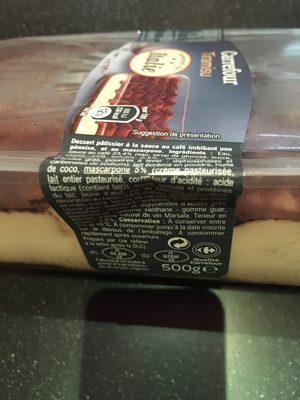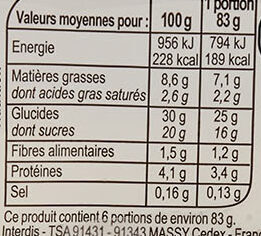Tiramisu au Café - Carrefour - 500 g
This product page is not complete. You can help to complete it by editing it and adding more data from the photos we have, or by taking more photos using the app for Android or iPhone/iPad. Thank you!
×
Some of the data for this product has been provided directly by the manufacturer Carrefour.
Barcode: 3245412702815 (EAN / EAN-13)
Common name: Dessert pâtissier composé d'une préparation au mascarpone et aromatisée 69% et d'une génoise imbibée de sauce au café 23,4%, saupoudré de cacao.
Quantity: 500 g
Brands: Carrefour
Categories: Dairies, Snacks, Desserts, Sweet snacks, Dairy desserts, Biscuits and cakes, Pastries, Tiramisu, Coffee tiramisu
Labels, certifications, awards:
Green Dot, Made in Italy, Nutriscore, Nutriscore Grade C
Origin of the product and/or its ingredients: Ce produit est fabriqué en Italie à partir de mascarpone d'origine Union Européenne, de vin Marsala d'origine Italie, ainsi que de café de diverses origines.Ce dessert pâtissier est fabriqué en Italie à partir de mascarpone composé de crème de lait et de lait d'origine Européenne, d'œufs d'origine Européenne et de café soluble et d'extrait de café issus de grains de diverses origines.
Producer: Fabriqué en Italie par A-27 pour Interdis. Fabriqué en Italie par A-27 S.p.A., via Cascinetta, 44 - 28013 Gattico (NO) Italie, pour Interdis.
Traceability code: IT Q7S5F CE
Stores: Carrefour
Countries where sold: France
Matching with your preferences
Environment
Carbon footprint
Packaging
Transportation
Other information
Other information: picto 6 personnes estampille Oeufs de poules élevées en plein air
Conservation conditions: À consommer jusqu'au : voir la date inscrite sur le dessus de l'emballage. À conserver entre 0°C et +6°C. À consommer dans les 2 jours après ouverture.
Customer service: Interdis - TSA 91431 - 91343 MASSY Cedex - France
Report a problem
Data sources
Product added on by kiliweb
Last edit of product page on by roboto-app.
Product page also edited by alexfauquette, carrefour, cyn, ecoscore-impact-estimator, naruyoko, openfoodfacts-contributors, org-carrefour, st-shade, telperion87.











